Dominican cuisine (the first of many) A tasty delight
One of the best things about the Caribbean (apart from the sun) is the delicious food; a lot of it uses banana or plantain as the base ingredient.
Food in restaurants: my experience in Adrián Tropical
A lot of tourists look for ways to please their taste buds. I found myself on holiday in the Dominican Republic and fortunately, I had incredibly good "hosts" who welcomed me and decided to take me to one of the most famous Dominican cuisine restaurants on the island: Adrián Tropical.
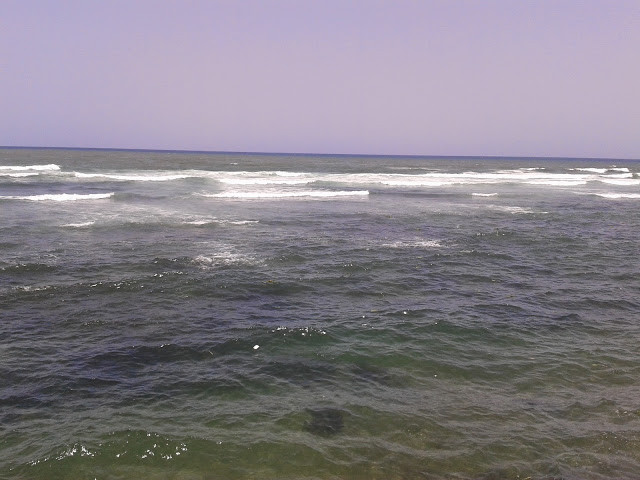
If you go to Adrián Tropical, you will receive first-class service whilst you relax, eating Dominican food with this view.
Being in the restaurant is incredible, more so than the one which is one Washington Avenue because if you sit outside, you will be able to enjoy a marvellous view of the sea close to Güibia Beach. Inside the restaurant, they occasionally sell hand-made souvenirs, such as elaborate jewellery made by the country's artisans. Imagine yourself trying delicious Dominican food for an excellent price, whilst feeling the sea-breeze on your face and wearing comfortable clothing so as to not get too hot and opening your eyes to see the sea in front of you. Anyone fancy that? No? Well don't hesitate and come to try a delicious dish at Adrián Tropical.
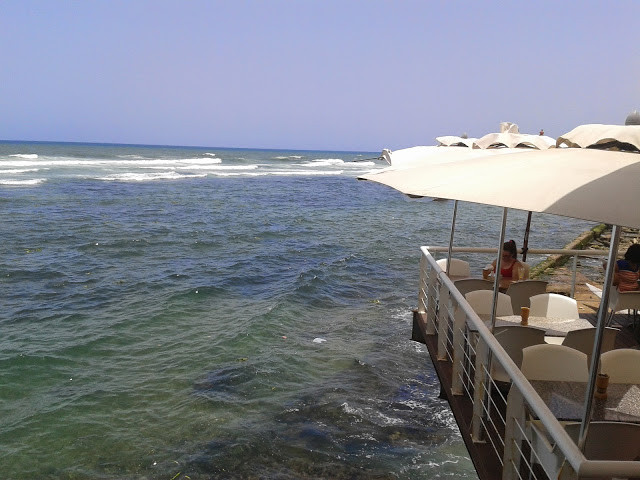
Eating outside at Adrián Tropical. The sea is literally underneath you.
The service is quite efficient. When I went, I was accompanied by Dominicans who helped me to choose the most delicious dishes to try. Something I always recommend is that everyone orders a different dish and then shares their dish with everyone else, this way you can try more than one dish, but only have to pay for one. Sharing like this always has its benefits, especially when travelling. I imagine that it's not everyday that you meet people that can help to guide you on what to order when travelling. This is why I'm going to give you some recommendations of the dishes that we tried and tell you the ones that we liked the most. Don't hesitate to send me a personal message to share what you think.
Mofongo
According to what they had told me, Mofongo has a very interesting history. A lot of people say that it is a Puerto Rican dish which was imported (or copied) by the Dominicans, but as this dish forms a part of the gastronomic heart of Dominica, a lot of people usually take offense when people say that they copied this dish, especially becuase I don't think relations between Puerto Ricans and Dominicans are too good. I think it's down to these "myths" that their problems haven't been resolved, but whilst the origin of Mofongo is still trying to be determined, it's best to just not mention the word "imported"! Haha.
In the following image, you can see the famous Mofongo as it is made in Adrián Tropical. It's made from a fried plantain base and mashed with garlic, it is then kneaded and served in a mortar. In Adrián Tropical, you can't not be served in a mortar, because although you can technically serve this dish on a normal plate, the mortar is a symbol of the Dominican kitchen; so they serve it to you in a very elegant, wooden mortar. The Mofongo that I ordered was a more traditional one, so it was also served with pork crackling - it's crunchy and incredibly tasty. The Dominicans usually eat it all the time and they say that it's good for hangovers - so it will help you when you've been partying too hard and you feel like your head is going to explode the following day.

My Mofongo, served in the wooden mortar so as to not lose any traditional value.
In Mexico and some other countries, we are used to buying and eating yellow plantain, which is better known as banana, whereas, in the Dominican Republic, they tend to be green, and these are known as "guineo". The Dominicans love to eat plantain becuase a lot (if not the majority) of their traditional dishes use plantain as the main ingredient.
How to make a good Mofongo
To prepare Mofongo is relatively simple. Firstly, green plantain is peeled and cut into pieces. Water is boiled with salt and they are left for around 10 minutes, after which, they are drained. The fattening part comes now - in a pan with a lot of oil, they add the pieces of plantain until they are cooked through. Meanwhile, garlic, salt and oil or butter are added to a mortar and mixed together.
Once the plantain is fried through, they are immediately put in the mortar with everything else and mixed together with the crackling. Something important to note is to never leave the plantain to get cold because they say that the heat is key for the flavour.
Don't forget that it's called Mofongo as there is another Dominican dish called "Mondongo" but they're not the same thing; even though the names are similar, don't get confused. In Adrián Tropical, this dish costs 144 Dominican Pesos which would be about £2. 40 or $3. 15USD.
Chicken Asopao
I think that eating the Mofongo was almost like an appetiser because when the chicken asopao came, my stomach started to tell me that it was filling up bit by bit. But this internal voice is easy to ignore when you grab your spoon and continue eating this delicious dish. It cost $279 Dominican Pesos (around £4. 50 or $6. 10USD). You can order either chicken asopao or prawn asopao; the prawn one is also really tasty, but a lot of people are allergic to prawns.
What does this famous asopao consist of? Well, basically it's a rice soup and together with the Mondongo, it makes part of one of the most representative dishes in the Dominican Republic. You'll find this dish under the section of the menu called "Tropricriollos" because it's considered as a Caribbean Creole recipe which mixes chicken cutlets, pumpkin, peppers (a type of "spiciness", but I'm from Mexico and it didn't seem at all spicy to me) cilantro and just a touch of orange. Let me tell you that considering it's a soup, it has a lot of consistency for the amount of ingredients that are included.
Part of what I like about trying food from other countries is that the majority of the dishes have a part of the culture embedded in each ingredient. It's pleasant to see how each dish is associated with some sort of family event or an important date in the country. The same can be said for asopoa; a lot of Dominicans associate it with affection because they usually prepare it when there is a family party, a birthday, celebrations or Christmas. This is what I mean when I associate love with food, it doesn't matter how far you go, this will always happen.
The dish is quite tasty and could even be considered healthy because there a quite a few vegetables in it, and together with the kind of thick texture, this dish is actually quite filling. (I almost couldn't fit in dessert! )

My chicken asopao was so delicious. Of course I shared it, because eating all this alone, nevermind on top of dessert, would be impossible...
How is Chicken Asopao prepared?
Firstly, the chicken is well seasoned with onion, pepper, garlic, salt and pepper (this is done to your taste). Meanwhile, you prepare a pan with enough oil to which you add a little sugar until it starts to brown. When this happens, add the chicken and leave it to cook for half an hour. After that, add some tomato paste and leave it to sauté, meanwhile on another hob, leave the longaniza (a type of spicy pork sausage) to cook. To the liquid that you get from frying the chicken, you have to add 4 cups of water and when it starts to boil, add the rest of the vegetables (potatoes, carrots or pumpkin) and the rice. As time goes by, the sauce will thicken out and then you add the chicken, sausage, corn and the orange juice which certainly gives it a special something.
Recommendations for you
As you already know, I couldn't try thousands of Dominican stews, but I asked some people what they thought was worth trying, and they recommended the following (from Adirán Tropical):
- Guinea Guisada (stewed plantain) it's called Guinea Guisada as they call plantain "guineo".
- Paticas Criollas (Creole hooves) a stew made with pig's foot.
- Arenque: it's like a paella with "asopao" and it's eaten with fish.
- Mondongo: Remember, it's different from "Mofongo". I'll explain what it is later on.
Finishing with a "broche de oro": the desserts
A while ago, I saw a meme which said that we actually have 2 stomachs, and the second one is used specially for desserts. I want to confess that although I know that we do only have one stomach, for some reason I always seem to have space for dessert and my time in Adrián Tropical was no exception. I was lucky enough to try a couple of desserts which I'm going to describe to see if you are encouraged to order this dessers or others because the menu has thousands of options which all have their charm.
Leche Cortada
Dulce de Leche (it's like caramel) is a very popular sweet in the Dominican Republic and it other Latin American countries; each country has it's own signature way of preparing it in different ways in order to give it a special touch.
Why is it called "leche cortada"?
This dessert is prepared by adding a little lemon juice to milk and this is what makes it "corte" (separate). The milk separates when something acidic is added, this will provoke the protein and they whey to separate, so the mix will merge in certain parts. The leche cortada costs $75 Dominican Pesos (£1. 20 or $1. 60USD). Not bad, not bad...
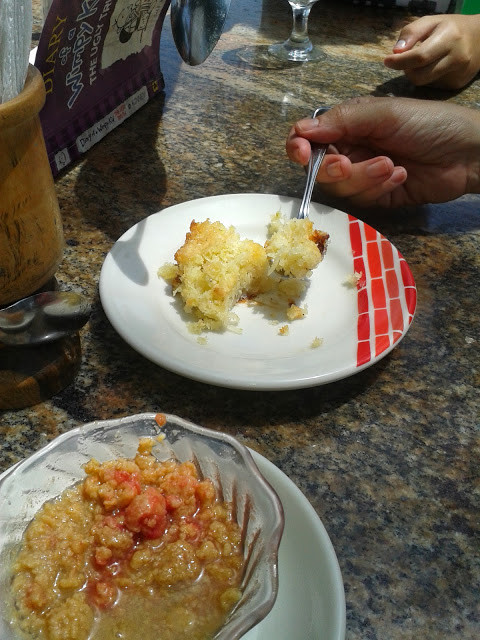
The leche cortada is the dessert at the bottom of the picture. Can you see the lumps formed from the milk separating? Guess what...? Mine came with rum!
How is it made?
Preparing this dish starts by putting the milk with cinnamon in a pan over a medium heat until a little before it starts boiling. Then the lemon juice is added so that the milk separates and then some sugar to sweeten it, however, they don't start to mix it until the lumps form. This dish also has egg in it, which they start to add slowly and then stir. The mix should be smooth and this is when they finally add the raisins, the vanilla and in some places they add rum too. It has to be left to cook for about 5 minutes and finally left to cool down. The mix stays lumpy, which is the characteristic touch of this "leche cortada" dish. Without a doubt - delicious!
Coco al horno (Baked Coconut)
The baked coconut is another Dominican treat; if I had to pick between baked coconut and "leche cortada", I would stick with the baked coconut. Both are delicious but being a coconut fanatic, this dessert surpassed my expectations. I don't want to come across like an advertiser, but coconut has a large amount of healthy vitamins, especially potassium. It also has a lot of vitamin E so it's also an antioxidant. If we're going to eat something sweet, then it should at least be beneficial to us.
It's difficult to turn down a dessert like this, especially when they serve it to you heated up with a golden finish. If you're a fan of coconut like me, you are going to love the taste, even more so if you're lucky enough that the coconut has just left the oven when they serve it to you. The coconut costs $85 Dominican Pesos which is about £1. 40 or $1. 90USD.

You can see the baked coconut (Coco al horno) at the top of the photo. Although the presentation isn't great, it's so tasty. If I hadn't been so full, I would have ordered 2 just for myself.
How is it made?
It starts by sifting flour, which is then put into an oven with salt. Once finished, in another container, coconut milk, evaporated milk, sugar, condensed milk, lemon peel and powdered cinnamon are mixed; the two mixes are then mixed with each other. When it's well mixed, it's put into an oven-safe container, but you have to mix it with butter before this. It's then baked for 45 minutes at 350 degrees and it's ready!
Other desserts that you should try
I still wanted to try more desserts, but I will undoubtedly return to Adrián Tropical (in a month more or less) and on my blog, you will be able to find opinions on the desserts that I wasn't able to try. However, the other ones which looked good and are definitely on my list are:
- Majarete: It's a sweet cream mixed with corn.
- Coconut Ice Cream
Homemade food
It's cool to go out and try Dominican cuisine in such good places like Adrián Tropical, but in life, you have to try everything, so I encouraged myself to go and try some other dishes which were homemade. My boyfriend's mum was asked to treat my palate to some homemade food. Just like in Mexico, you can't not have tortillas on the table, in the Dominican Republic, you can't not have green beans on the table (in Mexico, we call them "frijoles" but here they are called "habichuelas", rice, or the cherished Plátano verde (green plantain) which they are able to make more things with than I could have imagined.
Dominican Mangú
Mangú is another one of the most traditional and homemade Dominican dishes; they usually eat it for breakfast or at midday. I remember that we had it for dinner, which is not so common, haha.
Why is Mangú so important?
Because just like tortillas or chillies for Mexicans, Mangú is an important dietary custom for the Dominicans. Although this dish is traditional to the Dominicans, it's said to actually be from the Congo, where the word is actually used for an edible root.
If I noticed one thing during my stay in the Dominican Republic, it was that the dishes are really tasty, but they're not necessarily so elaborate or difficult to make. In Mexico, we have a rich cuisine, but my tastes are more complicated; anyone can make Mexican food, but not everyone could make good mole or good tamales. During my stay, I felt that some day I could cook all of this quite easily.

My dish of Mangú with ham and cheese. Accompanied by a fried egg, just how it should be.
How is Mangú prepared?
To prepare Mangú, you need plantain (the green ones), butter, water, salt to taste, onion and oil. Firstly, you start by peeling the plantain and cutting them so you can put them in a pain with water and salt. Leave it all to boil until the plantain is well cooked. Once taken out of the water, they are mashed and then butter and cold water is added so that they stay smooth. Oil is then added and they continue to be mashed until they have a smooth consistency. This dish is usually accompanied by pickled onion, although mine was with ham and cheese because I don't like onions.
This dish is also accompanied by an egg. I was given a fried egg on the side, and I actually really liked the mix and I'm not a big fan of egg. Before coming to this beautiful island, I never thought that a plantain could be cooked in so many different ways which are all so tasty!
My dinner: a delicious papaya milkshake
The dish that surprised me the most was the milkshake. I have to confess that I didn't think I would like it, but I took the risk and tried it for 2 reasons:
- It's rude if someone makes you something and you won't even try it because you don't like the main ingredient.
- It's not very often that you find yourself travelling and trying Dominican cuisine with people who love you and show you a lot of affection.
It was because of this that I dared myself to try the milkshake, which although the name of the dish is more Dominican than Mangú, it's something that can be made easily at home and still to this day I make them for myself when I'm in Mexico.
The milkshake is no more than milk, mixed with papaya and sugar. It's basically liquid papaya. The point is that I don't like papaya, but in this milkshake, I don't know how, but it tasted nice to me. I think that the recipe is the most easy in the world. I'm also going to share them because they make them at home, because you can find milk an papaya almost all over the world, especially if you live in Latin America.
How is the milkshake made?
Blend up two cups of spiced papaya, a cup of sugar, a teaspoon of vanilla, four cups of evaporated milk and two cups of ice cream. You need the ice cream to cool you down a bit in the Dominican heat.
So, you see how easy it is? You don't have any excuses not to make this, even if you are at home.
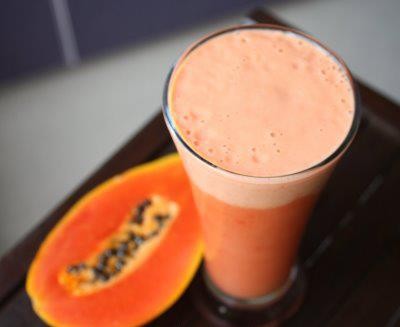
A papaya milkshake. Image link
Dominican fried snacks: some delicious "Caribas"
In Mexico, one of the companies which usually appears a lot in supermarkets regarding fried snacks is called "Sabritas". In a lot of countries, the company has a different name, but it's the one with a happy little face as a logo. In the Dominican Republic, the company is called "Frito Lay"; as you go to each country, you can see how the products change. In Mexico, almost all of the fried snacks contain chilli, whereas in the Dominican Republic it's common that the fried snacks contain... (you got it) Plantain!
I decided to eat some "Caribas" which are fried green plantain snacks. The plantain is thinly sliced, which are then fried with a lot of oil and finally, salt is added, just like "Sabritas" in Mexico which are made from sliced potatoes which are then fried and salted. It's the same thing, but with plantain. They seemed pretty similar to me, both are delicious.

My delicious Caribas. Here's a picture so you can remember what the packet looks like and buy them when you go to the Dominican Republic.
Dominican Mondongo
First of all, remember that Mondongo is phonetically similar to Mofongo, but they are not the same thing. Mondongo is another traditional dish in the Dominican Republic and is one of the most cherished, as well as familial seeing as these dishes which mum's or grandma's prepare are always present at special celebrations. In the countryside, it's a very common dish. If I'm remembering correctly, every country has its own version of "Mondongo". In Mexico it would be similar to "Pancita" (tripe), in Peru it would be "Cau Cau de Mondongo" and in Colombia, it's known as "Sancoho".
Its preparation is more elaborate. It's made with tripe and pig hoof meat cut into small pieces. It's seasoned with oregano, oranges, garlic, onions, peppers (it's not at all spicy! ) tomatoes, pumpkin, pepper, salt, parsley and bay leaves. Unfortunately, I was so excited to try it that I forgot to take photos of the dish, but here's an image from online.

Dominican Mondongo. Image Link
Conclusions
I hope to eat more Dominican food soon, so I can try the other recommendations of dishes, so wait for the next post about Dominican cuisine. So, try to make your own versions of the dishes, you won't regret the papaya milkshake which is so simple to make and the baked coconut which is delicious.
Greetings from Mexico!
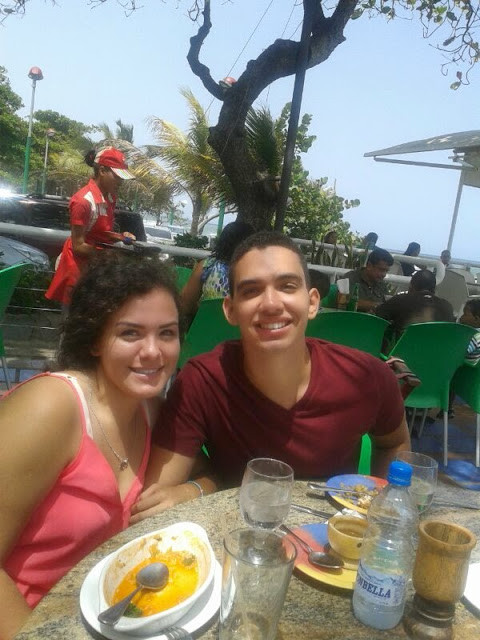
With the person that gave me the most marvellous tour of the Dominican Republic, thank you Alejandro! We were fatties together and in the photo, all of our plates are completely empty, what a shame! But... it was worth it!
Photo gallery
Content available in other languages
Want to have your own Erasmus blog?
If you are experiencing living abroad, you're an avid traveller or want to promote the city where you live... create your own blog and share your adventures!
I want to create my Erasmus blog! →















Comments (0 comments)